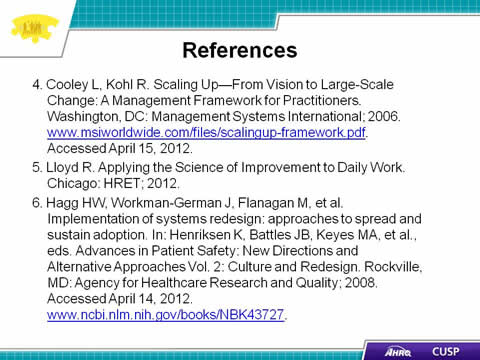CUSP Toolkit Spread Facilitator Notes
CUSP Toolkit
Contents
Slide 1. Cover Slide
Slide 2. Learning Objectives
Slide 3. Definition of Spread1
Slide 4. Why Spread?
Slide 5. Spread Framework2
Slide 6. External Factors Affecting Spread3
Slide 7. Internal Factors Affecting Spread3
Slide 8. Factors That Affect Spread
Slide 9. What Facilitates Spread Success?4
Slide 10. Spread Sequencing5
Slide 11. Developing a Plan for Spread
Slide 12. Work With the Next Unit
Slide 13. Account for Variability
Slide 14. Exercise: Develop a Spread Plan To Decrease CAUTI Rates
Slide 15. Evaluate Spread
Slide 16. Seven Spreadly Sins5
Slide 17. Summary
Slide 18. Tools
Slide 19. References
Slide 20. References
Slide 21. References
Slide 1. Cover Slide

Say:
The "Spread Module" module of the Comprehensive Unit-based Safety Program (or CUSP) Toolkit introduces Just Culture principles, which emphasize shared accountability and attitudes toward risk. This module also summarizes the concepts and activities of the other six modules in the CUSP Toolkit.
[D] Select for Text Description.
Slide 2. Learning Objectives

Say:
In this module, we will:
- Define spread and its role within an organization.
- Examine external and internal factors that affect spread.
- Present components of a spread plan.
- Discuss myths and barriers to spread.
[D] Select for Text Description.
Slide 3. Definition of Spread1

Say:
Spread takes a successful process that originated at the unit level (for example, a CUSP project) to a broader population in the organization. Initially, the organization should spread the new process to similar patient populations, shifts, units, or diagnoses. Organizations put the new process in place then review and tailor it, if necessary, to meet the needs of the new population.
[D] Select for Text Description.
Slide 4. Why Spread?

Say:
Because so many quality improvement projects are carried out at the unit level, staff members outside the unit may question the importance of spread. At the unit level, staff members can use resources such as Lean Six Sigma and Plan-Do-Study-Act to target a process for a small pilot project. At the unit level, a quality improvement project can thrive when staff members apply CUSP and TeamSTEPPS® tools.
[D] Select for Text Description.
Slide 5. Spread Framework2

Say:
The Institute for Healthcare Improvement's Spread Framework involves the following components:
- Leadership (including setup),
- Better ideas,
- Communication,
- Social system,
- Measurement and feedback, and
- Knowledge management.
Leadership
Organizational leadership plays a key role in spreading the success of the new process. When the process aligns with the organization's own strategic initiatives, it is easier for CUSP team leads to gain hospital leadership support. Once hospital leaders are on board, they should appoint a senior executive to the CUSP team to ensure its continued success. The Spread Assessment Tool can be used to help organizations assess their readiness to spread a process within the organization.
Better ideas
Ideas need to be evidence based, easily understood, and demonstratively beneficial. The stronger the evidence behind the idea, the more likely it is that staff members will adopt it and not argue over the evidence. Ideas cannot be overly complex or the idea to be spread will be lost during startup. Finally, the idea must clearly demonstrate that it offered a benefit to those who first used it.
Communication
Communicating the process to the organization at large and providing specific information to the CUSP team and patients is important. Communication should be clear and consistent to ensure staff members understand the process they are spreading and how it affects the population it is spreading to. Two common tools — the Voice of the Customer Analysis and Workflow Analysis — can help the organization gain valuable insight about staff members' understanding and reaction to the process.
Social system
A social system is an environment that is characterized by patterns of relationships and behaviors. For example, a social system within a unit could be senior-level staff members who have worked on the day shift for the last 4 years and do not readily accept changes in routines. Social systems are influenced by key messengers, level and availability of technical support, and transition issues. Understandably, a social system in a unit affects both the rate and success of spread.
Measurement and feedback
Measuring the effect of spread and gaining feedback from staff and patients about the process being spread generate better ideas about the process and ways to effect change. Measurement and feedback help the social system better understand new ideas and determine how easily an idea can be accepted into the social system's norms.
Knowledge management
Knowledge management and knowledge transfer consist of practices that create, capture, organize, and distribute information to other areas of an organization. It includes sharing both what steps were most successful, what steps to avoid, difficulties that were encountered, and other information that may increase the success of the process as it spreads to new areas. Essentially, knowledge management and knowledge transfer explore taking lessons learned in one unit and transferring those lessons to other units to create better ideas that fit with the social system.
Knowledge transfer can occur through team presentations, hospital-wide newsletters, a marketing campaign of the new process, and tours of a unit that had a successful pilot project. Aligning the outcomes of the new process with the strategic goals of the organization will allow continued spread of the knowledge through staff meetings, department meetings, and organization meetings.
[D] Select for Text Description.
Slide 6. External Factors Affecting Spread3

Say:
Several external and internal factors can influence spread success. Some of the external factors are:
- Financial: Will someone pay money for or make money from this process?
- Legal: Is the proposed process legal? Will someone sue because of it?
- Regulatory: Is reporting required?
- Public opinion: Will someone approve or disapprove of the new process?
- Moral: Will someone champion the new process?
- Organizational priorities: Do other issues take precedence over the new process?
Ask:
What are some of the external factors within your organization that can affect spread?
[D] Select for Text Description.
Slide 7. Internal Factors Affecting Spread3

Say:
Internal factors include:
- Leadership: Does the process align with the organization's mission, vision, and values? Is it coordinated with other initiatives?
- Availability of resources: Are there sufficient resources to accomplish patient care and put the new process in place?
- Knowledge and skill set: Will the new process require staff training?
- Organizational culture: Does the organizational culture embrace change?
- Ongoing improvement efforts: Will this new process fit into a coherent and coordinated improvement strategy?
- Other priorities: Will other priorities overwhelm the process being spread?
Ask:
What are some internal factors within your organization that can affect spread?
[D] Select for Text Description.
Slide 8. Factors That Affect Spread

Do:
Play the video.
Ask:
- How did the pilot CUSP team make a case for their project targeting adverse drug events?
- What resources did the pilot CUSP team identify for their project?
- What barriers did Mary and Kay identify for carrying out the project in their unit? How did the team address these barriers?
[D] Select for Text Description.
Slide 9. What Facilitates Spread Success?4
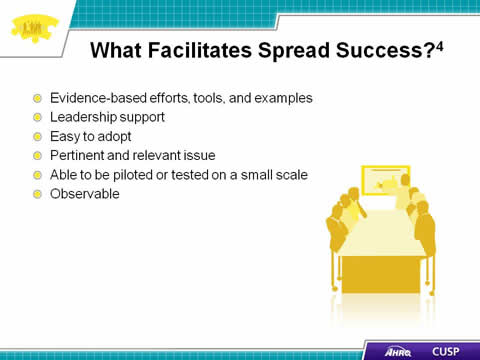
Say:
Research shows the following criteria facilitate spread:
- Evidence based: The CUSP team can make a strong case for the new process based on sound research.
- Leadership support: The organization's leadership believes in and supports the process being spread.
- Adoptable: The process is compatible with organization and unit values, attitudes, beliefs, and facilities.
- Pertinent and relevant: The unit believes the new process makes sense for and aligns with the work it does. For example, if a hospital is engaged in an organization-wide improvement initiative to decrease falls, the units most affected are floors with elderly patients. Having the Newborn Critical Care Center complete a falls risk assessment for each patient for each shift will likely result in center staff members rejecting the initiative because it is neither pertinent nor relevant to their patients.
- Able to be tested on a small scale: The unit can try out the new process without committing to full-scale deployment. Pilot tests let organizations assess components of the process to determine if they need modifications to meet unit needs.
- Observable: If units can see results, they will be more open to the process.
[D] Select for Text Description.
Slide 10. Spread Sequencing5

Say:
Improvement requires conducting small tests of change using a method such as a Plan-Do-Study-Act cycle. Once the team tests and improves the process in one unit, the team is ready to determine how to sustain the improvement in the tested area and spread it to other areas. This is referred to as the sequencing of improvement.
As organizations look to spread improvements, they need to consider the variability within the hospital. For example, if a hospital wants to spread a new process for patient identification, it can test the new process in a pilot unit. If the hospital then determines that all the medicine and surgical floors function similarly to the pilot unit, testing the new process on those floors may be unnecessary. However, the hospital may want to test the new process on the psychiatric unit because it houses a different patient population and may require a different process.
Spreading a process should go through a sequence of steps. As organizations spread a process, it may look very different from one hospital to another and from one unit to another. The patient population, the process, and the social system and culture of a unit can affect the ease of spread.
[D] Select for Text Description.
Slide 11. Developing a Plan for Spread

Say:
The previous slides showed the framework and components that facilitate spread. The next step is to explore the components of a spread plan. A spread plan helps ensure that the process, feedback, and next steps are documented. Here are the basic components of a spread plan and their suggested order of use. Organizations are encouraged to add components to address their needs and revisit the plan throughout the spread's progression. A spread plan should involve:
- Informing the team: The pilot unit and other units in the organization need to be made aware of the project. CUSP team leads should inform their teams and address any questions they may have.
- Working with the next unit to spread: A CUSP team member from the next unit that has been tasked with putting the new process in place can be invited to discussions with the pilot CUSP unit as the process is tested. Selecting similar units or areas in which to spread the process is often a successful strategy.
- Accounting for variability: An organization usually encounters variability when developing a process. The organization first develops a process that benefits the majority of patients and then works to identify and incorporate the variability of patient populations and clinical considerations. Variability does not consider staff preferences.
- Identifying units that can easily adopt the new process: An organization should examine unit data to determine which units can first put the new process in place without altering it too much. Units that are outliers—those units that will need to alter the steps of the process significantly—should wait to put the new process in place so they can benefit from the data collected and the lessons learned by the units that adopted the process earlier..
[D] Select for Text Description.
Slide 12. Work With the Next Unit

Do:
Play the video.
Ask:
- How is the shadowing opportunity used on Kavita's unit?
- How does Kavita use the 4 E's with her team?
[D] Select for Text Description.
Slide 13. Account for Variability

Do:
Play the video.
Ask:
- What differences does Kavita identify on her team?
- How does Kavita address these differences? What challenges did Kavita experience trying to spread the process and how did she address it?
[D] Select for Text Description.
Slide 14. Exercise: Develop a Spread Plan To Decrease CAUTI Rates

Say:
Hospital-acquired infections can often be prevented if the appropriate steps to protect patient safety are in place. Catheter-associated urinary tract infections, or CAUTIs, are an example of hospital-acquired infections that an organization can work toward reducing.
Working in small groups, develop a spread plan to decrease CAUTI rates by using the Healthcare Infection Control Practices Advisory Committee, or HICPAC, guidelines for catheter insertion and removal: www.cdc.gov/hicpac/projects_in_progress.html. As you develop the spread plan, consider the following:
- Similar patient populations.
- Similar physicians.
- Staff receptiveness.
- Unit leadership.
[D] Select for Text Description.
Slide 15. Evaluate Spread

Say:
Evaluating spread is an ongoing process that is measured both qualitatively and quantitatively. For example, for a falls prevention program, quantitative measures to evaluate can include the falls rate and the number of patients with fall risk assessments. Qualitative measures for the program can include feedback from participating staff about what worked well and what could be improved.
[D] Select for Text Description.
Slide 16. Seven Spreadly Sins5

Say:
Even with the best intentions, organizations can fall victim to what the Institute for Healthcare Improvement terms the “Seven Spreadly Sins.” These sins are:
-
Starting with large pilot programs.
A large pilot program will likely have too much variability. Conversely, a small pilot program will allow participating staff to identify barriers and provide feedback regarding the process and will allow staff to quickly test the process to determine its optimal use.
-
Finding one person who is willing to do it all.
Successful change involves an entire team's participation. Team participation will facilitate buy-in and identify key players for success.
-
Expecting vigilance and hard work to solve a problem.
Solutions that are simple and designed with very little risk of failure contribute to the success of the process and to its successful spread.
-
Deciding to spread the pilot project unchanged if it is successful on one unit.
A spread process needs to be tailored to address factors such as variability in patient type, care environment, and setup.
-
Requiring the person or team who drove the pilot program to be responsible for its system-wide spread.
One person or one team is unlikely to spread a new process throughout an organization because this causes burn-out, prevents the building of a strong infrastructure to support the change over time, and lacks the involvement of the local leaders who will be involved in the management and accountability steps needed to sustain change.
-
Looking at process and outcome measures quarterly.
Reviewing data only quarterly may prevent the timely awareness of an issue that requires immediate attention. Process and outcome data may need to be evaluated daily or every other day to provide feedback to those directly involved in the spread effort.
- Expecting early, marked improvement in outcomes without paying attention to process reliability
The Spread Checklist can help organizations identify gaps in their spread plan and determine whether they are committing any of the “Seven Spreadly Sins.”
[D] Select for Text Description.
Slide 17. Summary
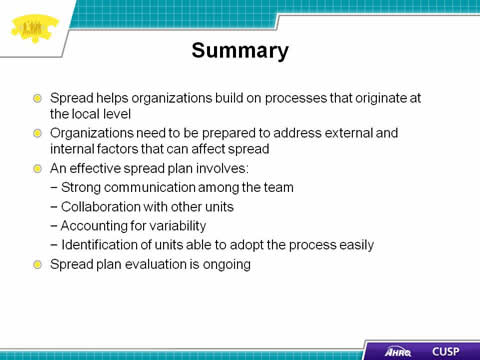
Say:
In summary:
- Spread can help organizations build on processes that originate at the unit level.
- Organizations need to address external and internal factors that can benefit or impede spread.
- An effective spread plan involves strong communication among members of the CUSP pilot team, collaboration with other units, consideration of variability across units, and identification of units that can easily adopt the process that is being spread.
- Organizations must continually evaluate the spread plan.
[D] Select for Text Description.
Slide 18. Tools
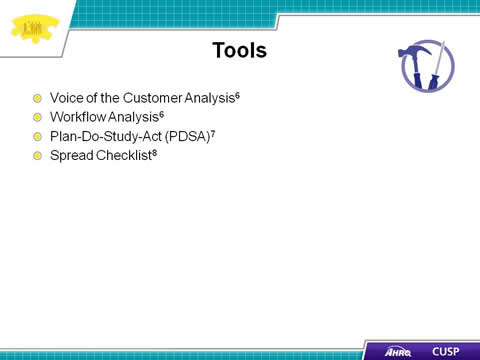
Say:
The tools listed below can assist with the spread process in an organization.
Voice of the Customer Analysis
This tool helps organizations understand how spreading a process across an organization will affect staff members.
Workflow Analysis
This tool helps an organization examine processes from the staff or patient perspective to identify opportunities for improvement.
Plan-Do-Study-Act (or PDSA)
This tool helps organizations test a change by planning, doing, studying, and acting on the change.
- Plan: Identify the team members who will participate in the change to be tested.
- Do: Document the change results and unexpected outcomes.
- Study: Analyze the results.
- Act: Determine the next steps.
Spread Checklist
The Institute for Healthcare Improvement offers a checklist that you can use throughout the spread process to ensure the plan is focused, the right people are involved, and communication is clear. Sample questions on the checklist include:
- Is improvement in this area a strategic initiative within the organization?
- Is there a senior executive responsible for the spread?
- Are changes packaged so they are easily understood and can be tested by adopters?
- Has the organization developed an initial plan for spread?
- How will the organization increase awareness of the initiative?
- How will the organization measure outcomes?
What information or reports will the organization use to gather and monitor feedback and refine the spread strategy?
[D] Select for Text Description.
Slide 19. References
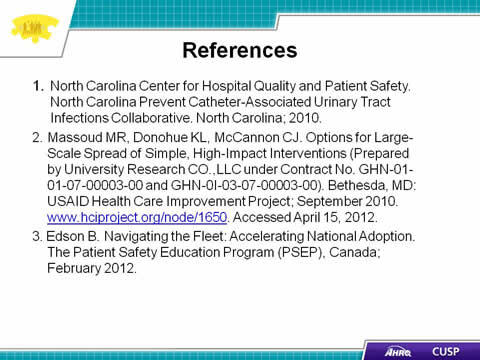
[D] Select for Text Description.
Slide 20. References
[D] Select for Text Description.
Slide 21. References
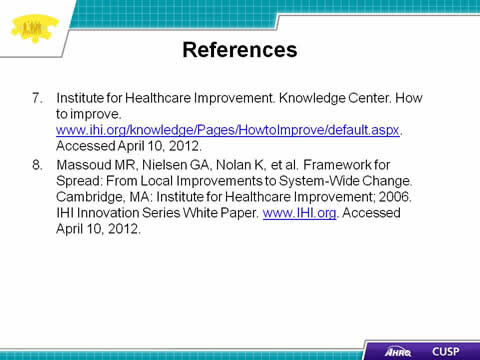
[D] Select for Text Description.




